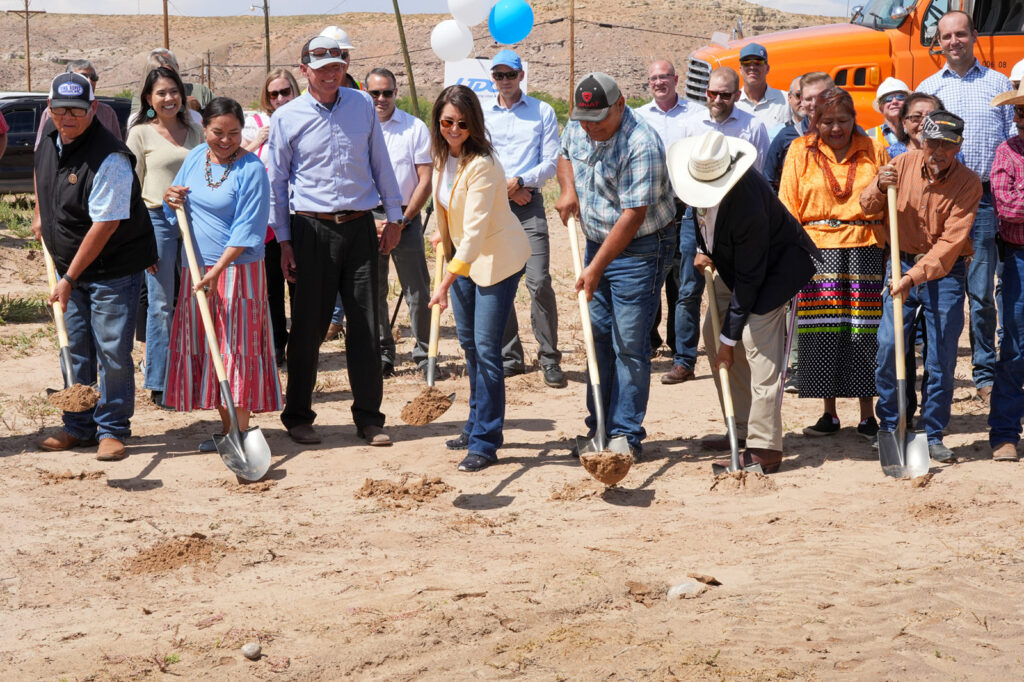A groundbreaking ceremony of the “Energy Corridor” on Aug. 13, 2024. (Photo courtesy of the Lieutenant Governor’s Office)
After years of negotiation with the Navajo Nation and environmental studies considering archaeological reclamation sites that had to be preserved, a southeastern Utah area will get updated roads in what the Utah Department of Transportation calls the Energy Corridor.
The hope is to serve and improve safety for residents, visitors in the Four Corners area, and workers in the petroleum extraction industry as they travel in the region.
The San Juan County 54-mile stretch encompasses state Route 162 and state Route 262, near Montezuma Creek, extending through Aneth, ending in the Colorado border.
UDOT has been studying making improvements to the roads since 2006. After years without resurfacing and only some maintenance efforts, those roads had become rough and bumpy, Devin Squire, a project manager at UDOT said.
“It’s been in the works for a really long time, and most of that is just the fact that it’s in a remote area, and it’s a really big project, and it has taken a while to resolve some of the right of way challenges,” Squire said.
Though Utah owns the roads, it didn’t own enough right of way to expand them to add safety measures. So, the state reached an agreement with the Navajo Nation to use some of its land in the area.
The tribe was concerned about granting the state a perpetual easement on the land, Squire said, so UDOT committed to only use the land to deal with the road.
“The Navajo Nation owns the property, and they’re allowing us to operate and maintain the roadway in that area until it is no longer a roadway,” Squire said.
Pottery pieces are shown during the groundbreaking ceremony of the “Energy Corridor” on Aug. 13, 2024. (Photo courtesy of the Lieutenant Governor’s Office)
UDOT and the Navajo Nation identified four archaeological sites within the project boundaries, which include a cooking site and pottery pieces. An archaeological team is digging and reclaiming the sites and will be monitoring them during construction, Squire said.
The state doesn’t anticipate further discoveries. However, it established a protocol to stop construction and protect the area if any other sites are found.
The projects
On SR-262, UDOT is rehabilitating the roadway surface, extending crossings underneath the road for stormwater, and adding shoulder improvements, Squire said, “basically dumping material off the side of the road and compacting it” to help motorists recover, or stop safely.
A map on display at the Energy Corridor groundbreaking event shows planned additions and improvements to roads in San Juan County on Aug. 13, 2024. (Photo courtesy of the Lieutenant Governor’s Office)
“If a car were to leave the roadway right now in this stretch, it wouldn’t be super catastrophic, but there’s not much room for error,” he said. “They’d go off the road five feet, and they’d end up in ditches and all sorts of crazy stuff.”
On the SR-262 corridor from Montezuma Creek to Bluff, UDOT is also cutting back the cliff to prevent rocks falling on the roadway.
The skewed intersection of SR-162 and SR-262 in Montezuma Creek, a heavily-traveled rural road, is set to become a roundabout.
“It’ll be a lot safer for students that are coming out of the high school and accessing some of the community services in Montezuma Creek, and overall, it should be way better than any other sort of traffic control option that we have for that area,” Squire said.
Additionally, the road between Montezuma Creek to Aneth, very close to the Colorado border, will undergo substantial work, including significant shoulder enhancements to give cars more room to avoid a steep fall into a river bottom that could be fatal, said Squire.
Funding
UDOT prepared three environmental documents to evaluate safety improvements on SR-162 and SR-262 between 2006 and 2018, Kevin Kitchen, senior communications manager at the department said.
After that planning, the work started in mid-August. While UDOT contractors work on the road, there will be some changes to keep traffic flowing.
“Because these highways have single lanes in each direction and many areas are adjacent to a river or have steep drop-offs, traffic will be alternated in several locations so that equipment can operate and material can be hauled and placed in needed locations,” Kitchen said. “Typically wait times of up to 15 minutes per flagging location can be anticipated.”
The project, scheduled to be completed by December 2025, has a price tag of $152.3 million.
The U.S. Department of Transportation Federal Highway Administration awarded $48 million for the project in 2019, part of its Nationally Significant Federal Lands and Tribal Projects grant, according to UDOT. The federal government also allocated $79 million through surface transportation and highway freight funds. And, $25 million came from the state’s pavement funds.
SUPPORT NEWS YOU TRUST.

